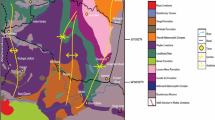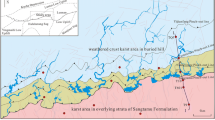Abstract
Calcitized Ordovician dolostones in the Yichuan-Huanglong area of the Ordos Basin (China) are discussed and evaluated by utilizing petrographic, mineralogical and geochemical data. Symbiotic dedolomites with red and white colors are separated and studied. The new data demonstrate that the red dedolomites (Dd1) occurred as the result of the migration of karst-related meteoric water that can be characterized by karst breccias, low Sr and high Mn contents, low δ13C values, high 87Sr/ 86Sr ratios and pure liquid–fluid inclusions. The occurrence of the white dedolomites (Dd2) around stylolites or pores, their low Mn contents, 110–120 °C homogenization temperature and hydrocarbon inclusions, associated with less depletion of δ13C than Dd1, suggest that Dd2 were formed under a burial hydrocarbon expulsion environment. Due to an insufficient amount of Ca ions from the dissolution of residual gypsum, the dedolomitization of Dd1 is a mole per mole replacement process along the rim interfaces, which retains the original pore system and provides pathways for hydrocarbon migration. The formation of Dd2 is a result of the dissolution/precipitation process of Dd1 and/or dolostones by the acidic fluids of mature hydrocarbons in the burial stage that completely convert the rock. The calcitized Ordovician dolostones in Ordos Basin is the result of continuous dedolomitization in an evolving environments from meteoric to burial.







Similar content being viewed by others
References
Al-Hashimi WS, Hemingway JE (1973) Recent dedolomitization and the origin of the rusty crusts of Northumberland. J Sediment Petrol 43:82–91
Ayora C, Taberner C, Saaltink MW et al (1998) The genesis of dedolomites: a discussion based on reactive transport modeling. J Hydrol 209:346–365
Baoxian L, Hongwei W, Zhanrong Ma et al (2011) Secondary limestone action on Ma5 member dolomites in Yichuan Huanglong Region of Southeastern Ordos Basin. Nat Gas Geosci 22(5):789–795
Bischoff JL, Julia R, Shanks WC et al (1994) Karstification without carbonic acid: bedrock dissolution gypsum-driven dedolomitization. Geology 22:995–998
Budai JM, Lohmann KC, Owen RM (1984) Burial dedolomite in the Mississippian Madison limestone, Wyoming and Utah thrust belt. J Sediment Petrol 54:276–288
Canaveras JC, Sánchez-Moral S, Calvo JP et al (1996) Dedolomites associated with karstification. An example of early dedolomitization in lacustrine sequences from the tertiary Madrid Basin, Central Spain. Carbonates Evaporites 11:85–103
Chilingar GV (1956) Dedolomitization: a review. AAPG Bull 40(4):762–764
Congbin Z, Shilu W, Shuyuan J (1996) Formation and evolution of caves in main production formation in the central part of Shan-Gan-Ning Gasfield. J Geol Min Res North China 11(1):73–79
De Groot K (1967) Experimental dedolomitization. J Sediment Petrol 37:1216–1220
Dongbo S, Hongping B, Liubin W et al (2019) Tectonic palaeogeography evolution and sedimentary filling characteristics of the Ordovicaian in the Ordos area. J Palaeogeography 21(4):537–556
Faure G, Hurley PM, Fairbairn HM (1963) An estimate of the isotopic composition of strontium in rocks of Precambrian Shield of North America. J Geophys Res 68:2323–2329
Faust GT (1949) Dedolomitization and its relation to a possible derivation of a magnesium-rich hydrothermal solution. Am Mineral 34:780–823
Folkman Y (1968) Diagenetic dedolomitization in the Albian-Cenomanian Yagur dolomite on Mount Carmel (northern Israel). J Sediment Petrol 39:380–385
Fu QL, Qing HR, Bergman KM (2008) Dedolomitization and calcite cementation in the middle Devonian Winnipegosis formation in Central Saskatchewan, Canada. Sedimentology 55:1623–1642
Goldstein RH (2001) Fluid inclusions in sedimentary and diagenetic systems. Lithos 24(55):159–193
Hongping B, Fan Y, Hai-feng B et al (2017) Sedimentology study on sub-member lithofacies paleogeography mapping and its petroleum exploration significance: Taking Ma5 member of Lower Ordovician Majiagou Formation in central-eastern Ordos Basin for example. Acta Petrologica Sinica 33(4):1094–1106
Huaguo W, Jixiang C, Longbin W et al (2016) Origin of dedolomite in the carboniferous of eastern Sichuan basin and its geological significance. Carbonates Evaporites 31:249–257
Jianxiong Q, Zuoshen Y (1997) Dedolomitization of carbonate rocks in Ordos and its relation to reservoir property. Oil Gas Geol 18(4):319–325
Jingli Y, Xinshan W, Daofeng Z et al (2010) Sedimentary microfacies of anhydrite concretion dolomite rock: take Majiagou Formation Ma513 layer in the eastern Ordos Basin as an example. Pet Explor Dev 37(6):690–695
Schoenherr J, Reuning L, Hallenberger M et al (2018) Dedolomitization: review and case study of uncommon mesogenetic formation conditions. Earth-Sci Rev 185:780–805
Kenny R (1992) Origin of discontinuity dedolomite in the Martin formation (late Devonian, northern Arizona). Sediment Geol 78:137–146
Land LS, Prezbindowski DR (1981) The origin and evolution of saline formation waters, lower Cretaceous carbonates, south-central Texas. USA J Hydrol 54:51–74
Lee MR (1994) Emplacement and diagenesis of gypsum and anhydrite in the late Permian Raisby Formation, northeast England. Proc Yorks Geol Soc 50:143–155
Lohmann KC (1988) Geochemical patterns of meteoric diagenetic systems and their application to studies of paleokarst. In: James NP, Choquette PW (eds) Paleokarst. Springer, New York
Margaritz M, Kafri U (1981) Stable isotope and Sr2+/Ca2+ evidence of diagenetic dedolomitization in a schizohaline environment: Cenomanian of Northern Israel. Sediment Geol 28:29–41
Mingqian HE, Wenhui H, Bo JIU (2020) Origin and evolution of favorable reservoir of gypsum dolomite in Ordos basin. Earth Sci Front. https://doi.org/10.13745/j.esf.sf.2020.5.6
Von Morlot A (1847) Über Dolomit und seine künstliche Darstellung aus Kalkstein. Haidinger; aus den Naturwissenschaftlichen Abhandlungen, Band 1. Wien, Braumüller, pp. 305
Munn D, Jackson DE (1980) Dedolomitization of lower carboniferous dolostone in the wirksworth area derbyshire England. Geol Mag 117:607–612
Perry EAJ, Turekian KK (1974) The effects of diagenesis on the redistribution of strontium isotopes in shales. Geochim Cosmochim Acta 38:929–935
Qing C, Jingzhou Z, Xiaohui Z et al (2013) Characteristics and significance of fluid inclusions from Majiagou Formation, Yichuan- Huangling area, Ordos Basin. Adv Earth Sci 28(7):819–828
Qingqing L, Bo L, Weimin J et al (2020) Diagenesis and pore evolution of dolomite reservoir in the 5th member of the Ordovician Majiagou Formation, central Ordos basin. Oil Gas Geol 41(1):102–115
Radwan OA, Dogan AU, Morsy MA et al (2021) One-step versus two-step dolomite calcitization (dedolomitization): differences and inferences. Geosci J. https://doi.org/10.1007/s12303-021-0004-8
Raines MA, Dewers TA (1997) Dedolomitization as a driving mechanism for karst generation in Permian Blaine Formation, southwestern Oklahoma, USA. Carbonates Evaporites 12:24–31
Rameil N (2008) Early diagenetic dolomitization and dedolomitization of late Jurassic and earliest Cretaceous platform carbonates: a case study from the Jura Mountains (NW Switzerland, E France). Sediment Geol 212:70–85
Ren Zhanli Yu, Qiang CJ et al (2017) Thermal history and its controls on oil and gas of the Ordos basin. Earth Sci Front 24(3):137–148
Reuning L, Schoenherr J, Heimann A et al (2009) Constraints on the diagenesis, stratigraphy and internal dynamics of the surface-piercing salt domes in the Ghaba Salt Basin (Oman): a comparison to the Ara Group in the South Oman Salt Basin. Geo Arabia 14(3):83–120
Riyuan X, Jiansheng T, Shengzhang Z et al (2006) Palaeo-karst research of the carbonate oil gas field and its application to oil gas exploration and development. Acta Geoscientica Sinica 27(5):503–509
Ronchi P, Jadoul F, Savino R (2004) Quaternary dedolomitization along fracture systems in a Late Triassic dolomitized platform (western southern Alps, Italy). Carbonates Evaporites 19:51–66
Sanz Rubio E, Sanchez Moral S, Canaveras JC et al (2001) Calcitization of MgCa carbonate and Ca sulfate deposits in a continental Tertiary basin (Calatayud Basin, NE Spain). Sediment Geol 140:123–142
Saunders JA, Toran LE (1994) Evidence for dedolomitization and mixing in Paleozoic carbonates near Oak Ridge, Tennessee. Ground Water 32:207–214
Stoessell RK, Klimentidis RE, Prezbindowski DR (1987) Dedolomitization in Na-Ca-Cl brines from 100″ to 200 °C at 300 bars. Geochim Cosmochim Acta 51:847–855
Theriault F, Hutcheon I (1987) Dolomitization and calcitization of the devonian grosmont formation Northern Alberta. J Sed Petrol 57(6):955–966
Török A (1997) Dolomitization and karst-related dedolomitization of Muschelkalk car-bonates, in South Hungary. Acta Geol Hung 40(4):441–462
Veizer J, Ala D, Azmy K et al (1999) 87Sr/86Sr, δ13C and δ18O evolution of Phanerozoic seawater. Chem Geol 161:59–88
Warrak M (1974) The petrology and origin of dedolomitized, veined or brecciated carbonate rock, the “cornieules” in the Frejus region, French Alps. J Geol Soc 130:229–247
Wierzbicki R, Dravis JJ, Al-Aasm I et al (2006) Burial dolomitization and dissolution of upper Jurassic Abenaki platform carbonates, deep Panuke reservoir, Nova Scotia, Canada. AAPG Bulettin 90(11):1843–1861
Wood GV, Armstrong AK (1975) Diagenesis and stratigraphy of the Lisburne Group limestone of the Sadlerochit Mountains and adjacent areas of northeastern Alaska U.S. Geol Survey Profess Paper 857:47
Yongtai Y, Wei Li, Long Ma (2005) Tectonic and stratigraphic controls of hydrocarbon systems in the Ordos basin: A multicycle cratonic basin in central China. AAPG Bulettin 89(2):255–269
Zeeh S, Becker F, Heggemann H (2000) Dedolomitization by meteoric fluids: the Korbach fissure of the Hessian Zechstein basin, Germany. J Geochem Explor 69(70):173–176
Zhongtang Su, Hongde C, Zhengjian O et al (2012) Sequence-based lithofacies and palaeogeography of Majiagou Formation in Ordos Basin. Geol China 39(3):623–633
Zixin H, Congbin Z, Caili W et al (2005) Case of discovery and exploration of marine field in China (Part 2): Jingbian gas field, ordos basin. Mar Origin Petrol Geol 10(2):37–44
Acknowledgements
We thank State Key Laboratory of Oil and Gas Reservoir Geology and Exploitation (Chengdu University of Technology; SDKL) and Changqing Oilfield Company for the permission to publish this research. SDKL is thanked for funding this research (The Open Fund (PLC2013202)). We thank Jiyao Fang and Kewei Xu for their help in doing experiments. We thank Xiuhua Li for her examination of the thin section.
Author information
Authors and Affiliations
Corresponding author
Additional information
Publisher's Note
Springer Nature remains neutral with regard to jurisdictional claims in published maps and institutional affiliations.
Rights and permissions
About this article
Cite this article
Su, Z., Luo, Z., Li, J. et al. Dedolomitization from the meteoric environment to the burial environment of Ordovician dolostones (China): results from petrographic and geochemical analyses. Carbonates Evaporites 37, 6 (2022). https://doi.org/10.1007/s13146-021-00745-2
Accepted:
Published:
DOI: https://doi.org/10.1007/s13146-021-00745-2




